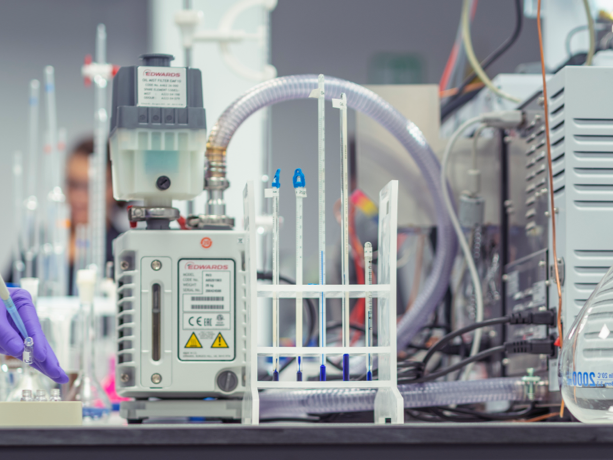Could Green Ammonia Replace Fossil Fuels for Shipping ?

With both war-related shocks and the decarbonisation agenda impacting fuel prices, the search is on for greener, more cost-effective fuels. Increasingly green ammonia is being offered up as the solution. But is it really ? Brookes Bell takes a closer look…
What is green ammonia?
The majority of the world’s ammonia is produced using the Haber-Bosch process, which as the name suggests, was invented by Fritz Haber and Carl Bosch.
This process involves reacting hydrogen and atmospheric nitrogen under pressure to make ammonia. However, until recently, to get this hydrogen involved burning fossil fuels - something scientists and policy makers alike are keen to get away from.
Enter green ammonia.
Green ammonia is still produced using the Haber-Bosch process, but uses hydrogen which has been derived from water electrolysis powered by alternative energy (e.g. solar or wind). As a result, the production of green ammonia is practically carbon dioxide-free.
Because of this, green ammonia has been seized upon as a potential way of drastically reducing the carbon emissions associated with the global shipping industry.
A note on blue ammonia
You may also occasionally see references to something called ‘blue ammonia’. This refers to ammonia whereby the hydrogen is produced using natural gas. The carbon dioxide emitted from the burning of this natural gas is then captured and stored in permanent reservoirs.
Whilst green ammonia is currently more expensive than blue ammonia, it’s expected that in the longer term green ammonia will win out due to the complexities involved in capturing and storing the emissions associated with blue ammonia.
The benefits of green ammonia
Producing enough green ammonia to supply the global shipping industry would involve huge amounts of investment and infrastructure changes.
Would it be worth it?
Below are some of the purported benefits of green ammonia, which if realised, would make the investment costs worthwhile.
Clean burning
Not only can green ammonia be produced with practically no carbon dioxide emissions, it doesn’t emit any CO₂ when burned either.
This makes it an ideal fuel for achieving the ambitious decarbonisation agenda set out by the International Maritime Organisation which aims to reduce emissions associated with shipping by 50 percent from 2008 levels by 2050.
Volumetric energy density
One of the failures of many alternative fuels is their lack of energy density. Sources like solar and wind require huge amounts of space in order to achieve similar energy outputs to fossil fuels like gas (solar and wind need on average 90-100 more space than natural gas to achieve the same energy density).
Green ammonia doesn’t suffer this problem, as it has a volumetric energy density that is broadly similar to methanol (and higher than hydrogen), meaning it could realistically be stored onboard vessels whilst also providing sufficient energy for longer voyages.
Ease of handling
Compared to alternative fuels like hydrogen, green ammonia is far easier to handle and store.
Green ammonia is stored in liquid form at temperatures of around -33ºC.
The challenges associated with green ammonia
If you’ve followed the global energy industry over the past few decades, you’re likely to have noticed a pattern; every few years a promising new green fuel appears, only to fizzle out failing to fulfil its promise.
If green ammonia doesn’t want to meet the same fate, then there are several challenges which need to be addressed.
Infrastructure
Whilst green ammonia infrastructure isn’t starting from a zero base - after all, ammonia has been produced for more than a century and 120 ports are equipped with ammonia terminals - but if it’s to fuel the global shipping industry, infrastructure will need to be scaled up significantly.
The current ammonia distribution network does connect production and storage locations, but it doesn’t currently reach ports in a way that allows ships to bunker.
Fixing that is going to require vast sums of capital.
A study in 2020 carried out by University Maritime Advisory Services (UMAS) and the Energy Transitions Commission found that over $1.4 trillion will be needed to achieve the IMO’s decarbonisation agenda by 2050. Of this $1.4 trillion figure, 87% will be needed for land-based infrastructure.
Nevertheless, some significant green ammonia infrastructure projects are already underway.
Arguably the most ambitious of these projects is the $5 billion joint venture in Saudi Arabia between US company Air Products, local company ACWA Power and NEOM, a land developer.
Should this project be successful, it’ll produce 1.2 million tons per year of ammonia.
But far more will be needed to meet the needs of the global shipping industry.
Safety issues
Green ammonia is admittedly far easier to handle than other alternative fuels and has the added bonus of being non-flammable.
However, concentrations of ammonia in the air of as little as 0.25% can cause fatalities. As a result, ammonia-based fuel systems will have to be designed to ensure the maximum safety of ships’ crews, port staff and others.
Safety protocols on ships will need completely overhauling, with new skills and standards deployed as well as new ways of investigating the potential negative impacts on human lives, water, soil etc should accidents occur.
Fleet readiness
Whilst ships have been carrying ammonia as a bulk cargo for decades, the industry has practically zero experience in using green ammonia as a fuel.
Not only will ships have to be adapted to handle this new fuel, but before that studies will have to be carried out to gauge the effects on fuel lines, engine parts and general corrosion and wear.
These studies and adaptations will also have to be accompanied by the introduction of rigorous risk assessment processes for fuel handling, working on propulsion systems and more.
On a positive note however, progress is being made on these issues with a number of projects underway to make green ammonia-propelled ships a reality.
For example, MAN Energy Solutions and Samsung Heavy Industries are hoping to launch the world’s first ammonia-fueled oil tanker by 2024.
What’s the future for green ammonia in shipping?
Compared to many other alternative fuels that have been proposed in the past, green ammonia appears to have a much more promising future.
But, challenges abound. As we’ve outlined above, there are some fairly sizable hurdles to be overcome; namely infrastructure and safety requirements, but according to some industry-leaders, these shouldn’t be considered insurmountable obstacles.
Interviewed in Hellenic Shipping News, the CEO of YARA, Mr. Magnus Ankarstrand, is bullish about the prospects of green ammonia, stating that “green ammonia will be cheaper than fossil fuels eventually”.
It’s a positive sentiment and one that we hope comes to pass. As the shipping industry continues to look for ways to combat carbon emissions, the emergence of green ammonia as a viable alternative fuel would doubtless be widely welcomed.
Have you got a question about your fuel?
Are you worried that one of your vessels may have fallen victim to contaminated fuel? Or perhaps you’re worried that your bunker fuel isn’t meeting the agreed specification?
Whatever your fuel-based query, The Lab’s fuel testing and analysis services can help.
Equipped to carry out the full range of ISO8217 Table 2 testing for marine distillate fuels and heavy fuel oils, The Lab is also geared for forensic testing using GCMS, FTIR, SEM, and EDX:
- Pyrolysis.
- Density.
- Ash content.
- Kinematic viscosity.
- Sulphur content.
So, no matter what your fuel testing and analysis requirements, The Lab can help.
Find out more about The Lab’s fuel testing and analysis services today
For more maritime and energy industry news and developments, explore The Lab’s News and Knowledge Hub…
Why Bunker Fuel Oil Analysis Is More Important Than Ever | What Is Non-Destructive Testing (NDT)? | Is Carbon Neutral Concrete on the Horizon
- Author
- Dr Caroline Young
- Date
- 07/09/2022
